This post is in collaboration with my friends at Stark Bro’s, my #1 online source for fruit and nut trees, shrubs and other edible plants. All opinions and words are my own.
Planting blueberry bushes in my garden was one of the first things I did when I moved into my new house years ago. To me, it was like investing. The earlier I set up my perennials, the longer I enjoyed their fabulous returns, and the bigger the plants would get, compounding my interest—ahem, blueberries—over time. Not only are blueberries beautiful deciduous landscape shrubs with many varieties turning a scarlet red and orange in the fall, but they reliably produce delicious berries, year after year.
Blueberries are also one of the easier edible perennials to get started with since they’re small (i.e. not 30 foot tall fruit trees) and don’t require a berry trellis, which most blackberries and raspberries benefit from.
Looking to add this fab fruit to your backyard or front yard garden? This planting guide is everything you need to know about getting the best variety, location, fertilizer, soil type and pH, plus when and how to plant them. I promise, easy peasy!
Blueberry Growing
First, before picking varieties or pulling out a shovel, a quick primer on when, how, and where blueberries grow…
When Do Blueberries Grow?
Blueberries are deciduous, meaning they lose their leaves every fall. In spring, new leaves sprout, and tiny powder blue (or sometimes pink) bell-shaped blueberry flowers emerge. Depending on the variety, between June and mid-September, these flowers will transform into blueberries, ready to harvest.
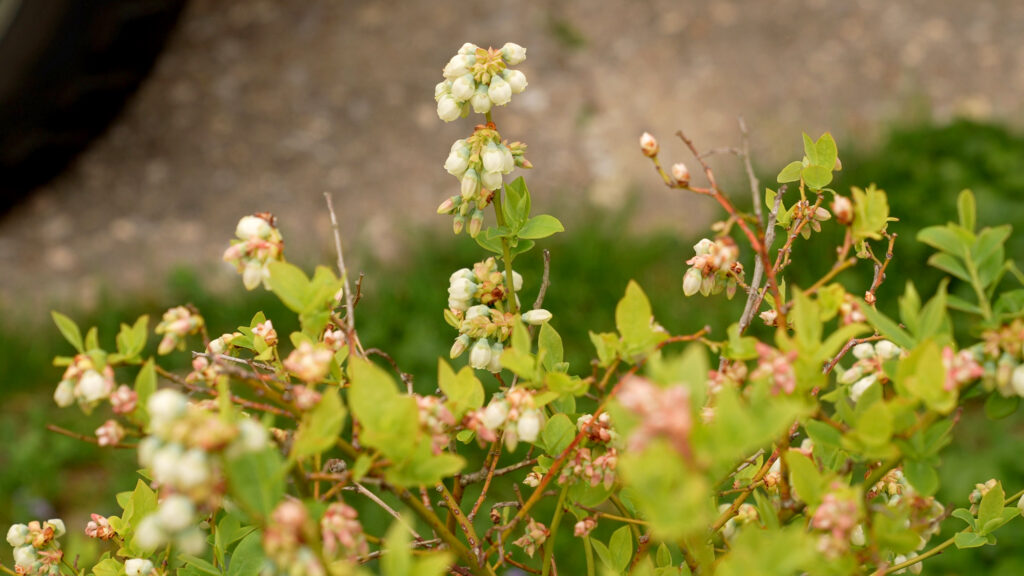
How Long Do Blueberry Bushes Live?
Blueberries reach their mature, full size around the 8-10 year mark and can live for as long as 50 years. See why I was so anxious to get these guys in the ground?
Do Blueberries Grow on Vines?
No! Blueberries are upright bushes with woody stems and branches. In fact, if you’re looking at a vine with blue berries (not “blueberries”), you could be looking at either Boston Ivy or Virginia Creeper. Both of these berries are toxic. Do not eat them! (And just, in case you were wondering, as a rule, you shouldn’t eat anything you can’t for sure identify. Just sayin.)
Can Blueberries Be Grown From Seed?
Technically, yes. You can extract seed from blueberry fruit or purchase commercially available seed. While I’ve never tried planting blueberry seeds, I can’t say I’m too enthused about the idea. As with many perennials, planting from seed means you’ll be waiting forever for a harvest, minimum two years in the case of blueberries, likely longer.
Propagating Blueberry Cuttings
Blueberries can also be grown by taking cuttings from the hardwood of existing blueberry plants and planting them, or “propagating” them. They will be ready to plant outside after one year. Not only does this involve some rather advanced techniques and babysitting of a seedling for an entire year, like the seeding method, you’ll need to wait considerable time to get a harvest. In addition, not just any donor plants will do. You’ll want virus- and disease-free plants, preferably from different varieties, to improve pollination.
Buying Blueberry Plants For Sale
The route I took, and the one I recommend is to purchase blueberry plants for sale from a reputable plant nursery. This means you don’t have to take care of finicky seedlings for a year and you’ll harvest years sooner. (Hello, more blueberries!)
For at least 15 years, I’ve been buying my plants from Stark Bro’s. I got my blackberries, my strawberries, my raspberries, my potato seeds, my sweet potato slips, plus recent additions to my blueberry hedge all from Stark Bro’s.
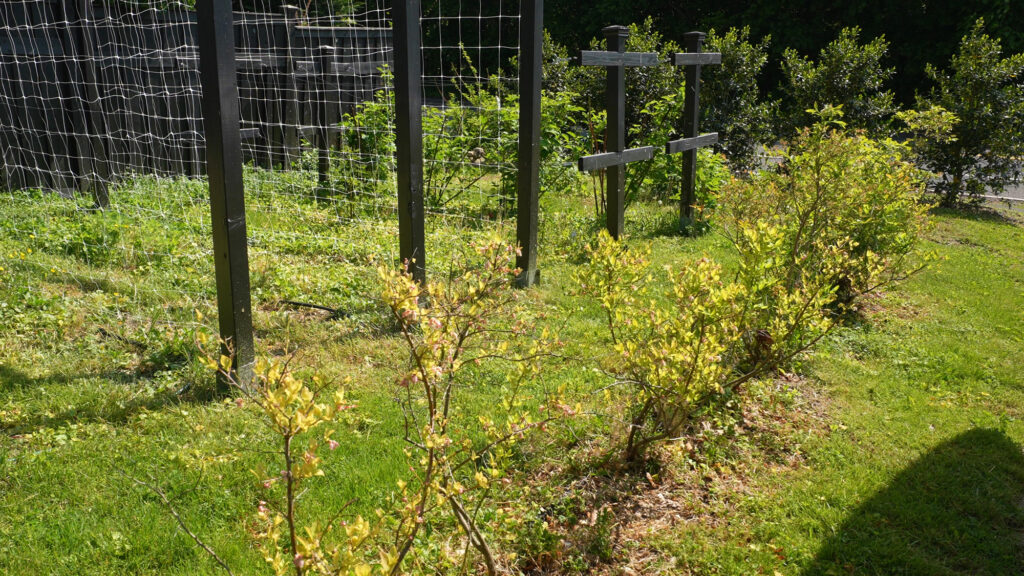
Because I had existing blueberry bushes in my garden, it was even more important to me to get healthy plants that wouldn’t infect my existing blueberry hedge. Part of the reason I’ve been with Stark Bro’s for so long is not only do they have a pest- and disease-free promise but they also have a 1-Year Survival Guarantee where they replace or refund your plant purchase if it dies within a year. No matter what nursery you buy your plants from, I definitely recommend asking what kind of plant guarantees they have.
Blueberry plants for sale can be sold either dormant (without leaves, in the winter) or leafed out during other times of the year. They come in a variety of sizes:
- Bare root blueberries, with just the roots, no soil, similar to raspberries and strawberries
- Potted blueberries (4 inches, 1 gallon, and 3 gallon sizes are common)
- Full-grown mature blueberry bushes (harder to find and more expensive)
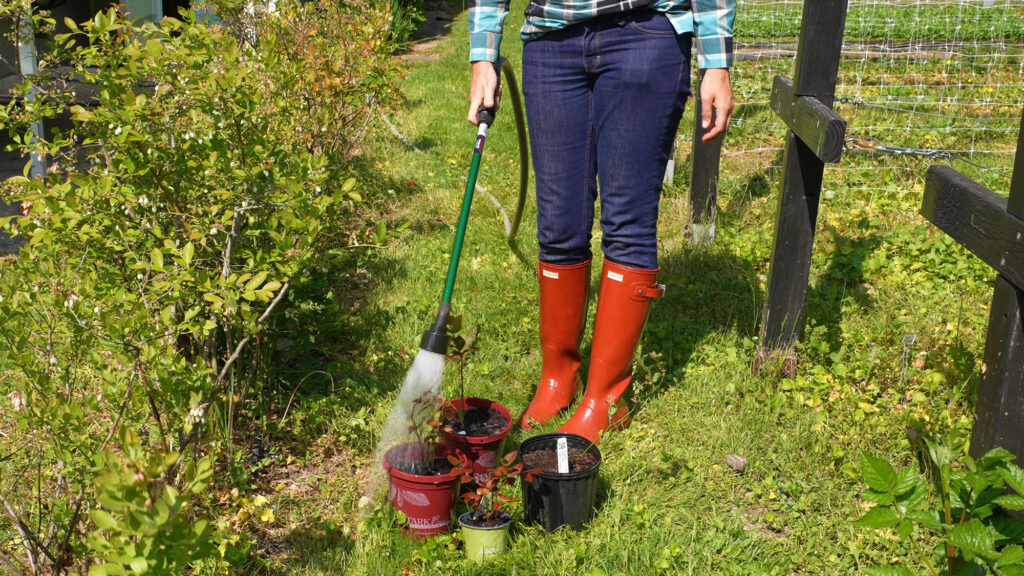
Blueberry Growing Zone
Blueberries can be grown in most U.S.D.A. plant hardiness zones of the United States, zone 2 in the north all the way south down to zone 10. Make sure you check the variety though! It’s difficult to find varieties for the more extreme zones, especially south. If you’re purchasing online like me, I was able to click one checkbox on the Stark Bro’s website to filter the varieties to just my zone, zone 7a.
When To Plant Blueberries
You can plant blueberry bushes at two times in the year—in the fall or in the early spring after your last frost. While you can do either, I’m a bit partial to fall planting when I can, only because there are so many other things to plant in the spring! If you’re not sure of your last frost dates, The National Gardening Association has a great online tool to look up your frost dates by zip code. In my zone 7 garden, for example, my last frost date is May 5th.
Blueberry Pollination
All blueberries require pollination of their flowers, but some require pollination from different varieties to bear fruit. These types are called cross-pollinating blueberries. The best pollinators are varieties that bloom at the same time. Good nurseries will tell you the best companion varieties.
Self-pollinating blueberry bushes (also called self-fertile blueberries) do not need another variety. Single plants can even pollinate themselves, making them incredibly popular with patio gardeners. That being said, all self-fertile plants will do better if there are other varieties present.
When you buy your bushes, they should be marked as “requires cross-pollination” or “self-fertile.” Because I have a small garden, I always choose self-pollinating when I can, since I rarely have a lot of space to dedicate to a single crop. My blueberry hedge is a different matter though! I love blueberries and have 18 bushes now. Even still, they are all self-pollinating varieties. (You can say I like to “hedge” my bets!)
Types of Blueberries: Highbush vs. Lowbush Blueberries
Blueberry bushes come in two types:
- The highbush blueberry (vaccinium corymbosum) can grow 6-12′ wide and tall but some patio varieties come as small as 2′ wide and tall. It’s native to eastern North America and is sometimes called high blueberry, blue huckleberry, tall huckleberry, swamp blueberry or swamp huckleberry. Highbush blueberries are further divided into the Northern Highbush type (for colder climates) and the Southern Highbush type (for warmer climates).
- The lowbush blueberry (vaccinium angustifolium) is a spreading shrub, only 2-24 inches high. It’s native to northeastern North America, and is sometimes called wild lowbush blueberry. Maine’s famous wild blueberries (and also their state fruit) are this type.
Most blueberries grown commercially and by the home gardener are the highbush blueberry type.
Blueberry Varieties
There are an amazing number of blueberry varieties, for almost every climate, in every size, even organic blueberry plants. This year I’m adding these varieties to my garden:
Some other popular varieties include: Sunshine Blue, Duke, Jersey, Bluecrop, Top Hat, Brightwell, Elliot, Rabbiteye, and Powder Blue.
Blueberry bushes also make great container plants and Bushel and Berry blueberries are one of the top brands if you’re looking for this type. Check out this adorable variety, the Pink Lemonade, that grows, you guessed it, pink blueberries!
Blueberry Shade (and Sun!) Requirements
Like most edibles in the garden, blueberries do best with full sun, meaning a minimum of 6 hours of direct sunlight per day. They will tolerate partial shade but they’ll produce less fruit.
Best Place To Plant Blueberries
The best place to plant blueberries is as close to your mouth as you can get them! Ok, all joking aside, there are so many varieties of blueberries that you can plant them just about anywhere and in any container (or none at all) and it could be considered the best way to grow blueberries for your situation.
Growing Blueberries in Pots
One of the most popular methods is growing blueberries in pots or in containers. Some people even grow blueberries in 5 gallon buckets. Pots are perfect for patios, rooftops, porches, and courtyards. And while I haven’t done it with blueberries, I like to use containers to reclaim paved areas of my front yard for planting. My driveway in particular gets incredible sun.
What’s great about patio blueberry bushes is that (besides being close for snacking) they can easily be brought indoors. While I don’t recommend doing this year round, bringing a blueberry bush indoors during certain times of the year is a great way to get around an extremely cold (zone 1) or extremely tropical climate (zones 11+). You can have your blueberries and eat them, too!
Blueberries in Raised Beds
Planting blueberries in raised beds can absolutely be done, but it’s definitely not the most common method and probably not the best. Blueberries are perennials and can live for up to 50 years. If you plant in raised beds, just make sure that your beds have a similar lifespan. While my wood raised beds are incredibly heavy duty and well-maintained, there is no way I’d get 50 years out of them.
Planting Blueberries in the Ground
Planting blueberries in the ground is the method of choice in my garden. Along my driveway, creating a low fence of sorts in front of my trellis area, I have a blueberry bush hedge. I love this hedge for a couple of reasons:
- It creates a “garden room” out of my trellis area.
- It’s not as imposing as other types of barriers, like a fence. With so many imposing structures like my vegetable trellises and blackberry trellises already in my front yard, this is a plus!
- To create the hedge effect, the bushes are planted super-tight (2 feet apart), but that just means I can squeeze more plants into the same amount of space.
- Blueberry bushes in the fall make the garden look amazing as they turn a beautiful crimson color.
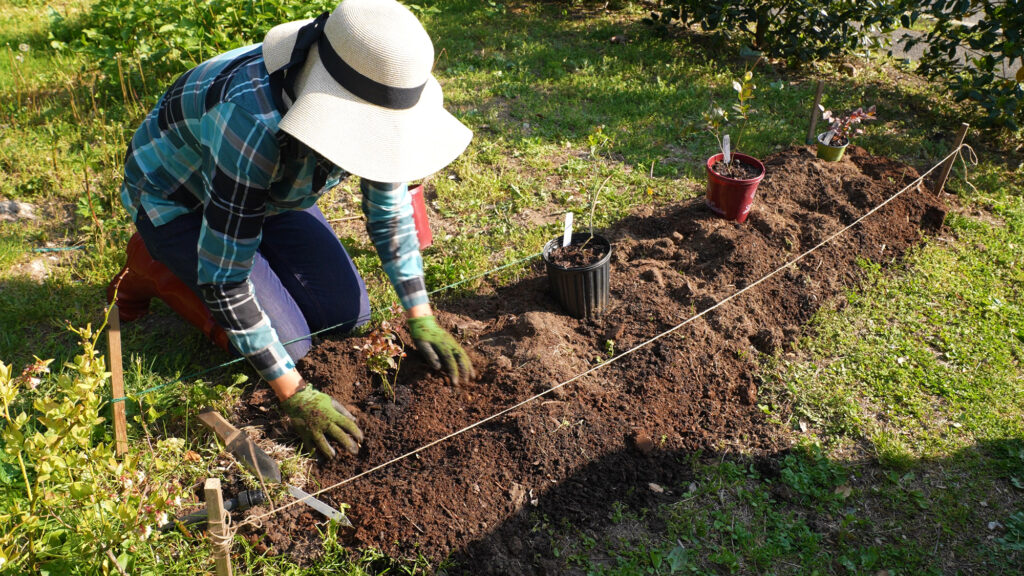
There are three drawbacks to this placement, though.
- These bushes get a lot of abuse in the winter, when we shovel our driveway and pile up snow nearby.
- Our driveway is pretty skinny, so these bushes also get abuse from car doors and pedestrians.
- Blueberry bushes in winter don’t look that great since they lose their leaves. I may try to plant something low-growing and evergreen in front of them but whatever that is, it would also need to endure snow shovel and driveway abuse.
All in all, though, I’m happy with the placement. When you have a small garden, there is always going to spots that are not 100% perfect. Better to have something in that spot, even if it’s not ideal.
Transplanting Blueberries
Not sure if you have the right spot in your garden? Transplanting blueberries is an easy task and they take well to it since they have a shallow root system. In fact, I’ve transplanted my blueberries at least three times in the last 15 years.
Amending Soil For Blueberries
Yes, blueberries tolerate shade, have few pests (besides birds), do well in a variety of containers, require no support, can be transplanted easily, come in a huge variety of sizes, and are great for just about every climate. Up until now, I’ve probably given you impression that blueberries are a beginner plant. Please forgive me, because this is where things are about to get serious.
Blueberries are soil grumps. Amending and preparing soil for blueberries is like making lunch for a two year old. Yes, they will survive if their PB&J has crusts, but they will not be happy and they will let you know about it.

Blueberry Soil Type & Drainage
Like a lot of edibles, your ideal blueberry soil type is going to be loose, well-drained and full of organic material. If you’re planting in a container, potting soil for blueberries or other acid-loving plants is the way to go here. If you’re planting in-ground like me, here are some ways you can loosen up soil and get some organic matter:
- Use a broadfork or garden fork to physically loosen soil
- Add sand (unless your have clay soil!)
- Grow a cover crop if you have time
- Add organic matter, like compost, straw, or mulch
The trellis area in my garden is pretty compacted but the soil’s not terrible. So my solution is the one-two-punch of the garden fork-compost combo. I forked the area and removed the grass (ahem, weeds), roots, and rocks. Then I mixed in the compost. Compost is fast, you can make it at home, has different particle sizes that increase drainage and offers nutrition to growing plants.
Blueberry Soil pH
Here’s another area where things get complicated—blueberry soil pH.
You need acidic soil for blueberries, period. Without acid soil, blueberries won’t produce as much fruit, their leaves will discolor, and they will generally not thrive. “Acidic soil” means soil that has a pH of less than 5.5. In fact, blueberries prefer their soil much lower, between 4.0 and 5.5.
Not sure about the acidity of your soil? You can purchase an inexpensive soil pH testing kit or, if you’re in the United States, get your soil tested by your local university extension.
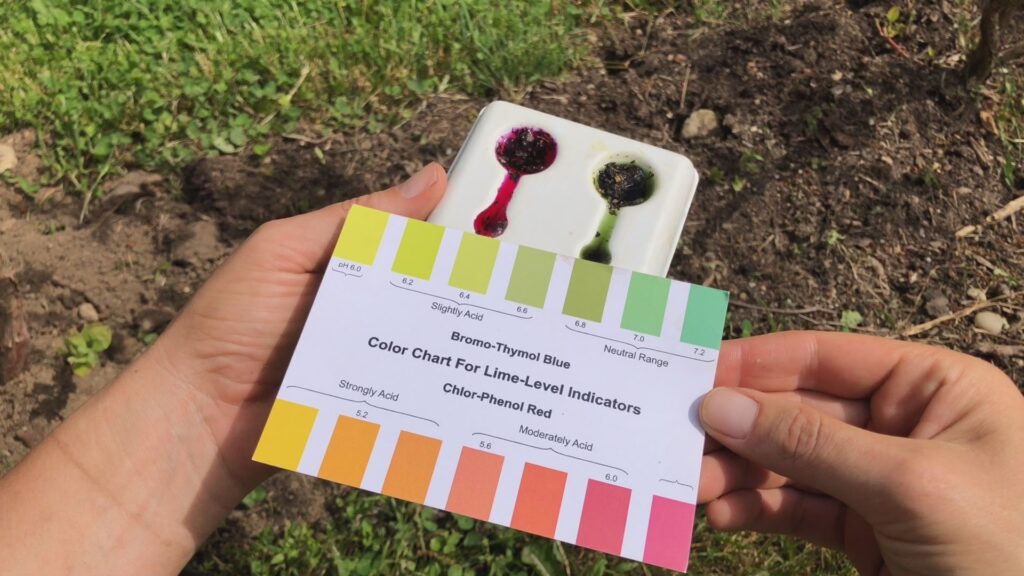
If you need to acidify your soil for blueberries, which I did, there’s a few ways to do this.
- Soil acidifier (Espoma and Jobe both make organic and OMRI-listed ones)
- Acid fertilizer (my favorite is Down-to-Earth 4-3-6 Acid Fertilizer, also organic and OMRI-listed)
- Sulfur
- Peat moss
For a long time, my go-to was peat moss, because it was inexpensive and also improved soil drainage at the same time as acidifying the soil. Because of the environmental damage of peat mining and its contribution to climate change, I can no longer recommend this amendment in good conscience, especially not with so many other great options.
Blueberry Fertilizer
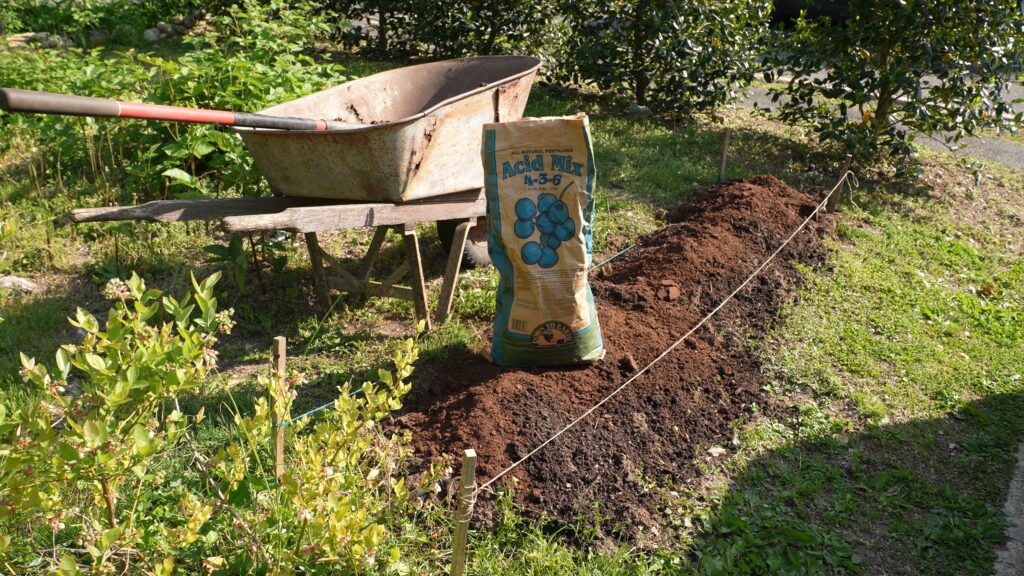
In addition to soil prep, blueberries are also finicky about their fertilizer. It’s easy to over-fertilize them causing damage to the bushes. They also don’t absorb fertilizer the same way as plants that thrive in soil with a more neutral pH level.
Your best best is to get a fertilizer that is specifically formulated for fertilizing blueberries. Some blueberry fertilizer options include the Down-to-Earth fertilizer (mentioned above), Espoma’s Berry-Tone (better than their Holly-Tone fertilizer, also organic and OMRI-listed), and the Stark Blueberry Special Fertilizer.
When to fertilize blueberries:
- Spring – Established blueberries should be fertilized when you see new spring growth. New blueberries should be fertilized when their first true leaves have reached full size.
- Spring & Summer – Every six weeks until the middle of summer (on or about July 1 for northern hemisphere folks)
- Summer – When the fruit is formed but hasn’t turned blue yet
Blueberry roots can burn from fertilizer since their roots are close to the surface. (See note about mulching below.) No matter when you’re fertilizing, always make sure that you’ve irrigated or it has rained since the last fertilizer application.
Planting Blueberry Bushes
Once the soil situation is nailed down, planting blueberry bushes is a cinch. All you need to do is determine your blueberry plant spacing. Always check your variety for specific size and spacing recommendations, but some general guidelines are:
- Highbush blueberry spacing – 4-6 feet between bushes
- Lowbush blueberry spacing – 2-4 feet between bushes
- “Half High” blueberry spacing – 3 feet between bushes
- Blueberry row spacing – 6-8 feet between rows
- Blueberry hedge spacing – 2-2.5 feet between bushes
Because blueberries are ornamental, feel free to plant them in your regular beds and show them off! That’s what I did. Just keep in mind you might need to protect them from birds.
Another tip—don’t plant blueberries too deep. The soil in the nursery pot should line up exactly with your new surrounding soil. Blueberries have shallow roots and can be damaged if they’re planted too deep.
Check out exactly how the pros do it at Stark Bro’s in this fantastic video.
Watering Blueberries
Once your bushes are in the ground, watering blueberries deeply will settle the soil and get them off to a great start. You can use a hose, watering can, or create an automatic watering setup, like my customized soaker hose irrigation system.
Mulching Blueberries
Mulching blueberries is the final step to a rock-solid blueberry planting. What does mulch do?
- Cut down on your weeding duties
- Keep weeds (or grass) from stealing water and nutrients from your blueberries
- Preserve soil moisture and prevent withering
- Prevent fertilizer burn
- Look more attractive
You want mulch material that allows water to get through, so avoid things like plastic or even grass clippings, which can form a thick mat. Good options for mulch are pine needles, bark, or wood chips. Every region is different, but landscapers in my area will deliver free wood chips since it’s a “waste” product from our huge suburban landscaping industry.
Apply mulch 4-6 inches deep out to the drip line, the outer edge of where the branches canopy the ground. Just don’t allow the mulch to touch the main stem since this could cause rotting.
Want to Start Growing Blueberries?
As a wrap-up, yes, blueberries can absolutely be challenging in the initial soil setup, but what a great long-term investment in your garden! With very little ongoing maintenance, you really can’t get any better than 50 years of blueberries. Smoothies, jam, in your cereal, and yogurt… there’s just so many ways to use blueberries. And blueberries are not cheap or even always available at the grocery store! They were the first thing I planted in my garden years ago and I would tell anyone starting a new garden to put them on their shortlist too.
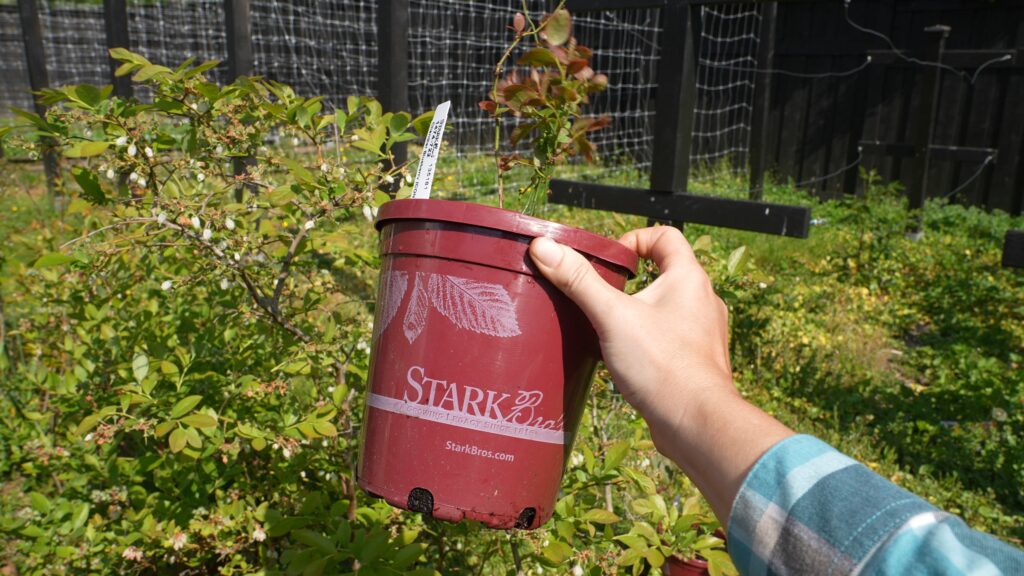
If you’re looking for a great nursery, I have been shopping at Stark Bro’s for over 15 years and can’t recommend them enough. The number of varieties Stark offers is unmatchable and their website is so incredibly easy to shop at. If you’re like me, you might have specific requirements for your plants, like pollination, spacing, size or zone. All that info is super easy to find. You can even filter their shop by blueberry flavor—sweet, mild or tart. Imagine getting that information out of a big box retailer… not! Not to mention every time I get a plant shipment from them, I am astounded at how undisturbed the plants look, especially knowing the full-breadth of my UPS person’s manhandling ability.
If you are in the market to buy blueberries, or any other fruit, nut tree or edible, I highly recommend Stark Bro’s. I’m so excited to be partnering with them on this post. Stay tuned for more with them soon!
Sources
- Growing Blueberries From Seed, University of Maine
- Growing blueberries in the home garden, University of Minnesota Extension
- Planting Blueberry Plants, Stark Bro’s
- Watering, Fertilizing, Harvesting Blueberries, University of Maryland Extension
- Blueberry Propagation, Extension Foundation, National Institute of Food & Agriculture
- Frequently Asked Questions for High Bush Blueberries, University of Maine
- Growing Blueberries for Beginners, West Virginia University
- Vaccinium corymbosum, Wikipedia
- What to do about compacted soil, Michigan State University
- Harvesting peat moss contributes to climate change, Oregon State scientist says, Oregon State University
- Fertilizing Blueberry Plants, Stark Bro’s
- Suggested Blueberry Fertilization Timings and Rates, University of Georgia Extension
- Planting Blueberries, U.S. Highbush Blueberry Council
- Growing Bluberries in Your Home Garden, Oregon State University Extension Service
- Suggested Fertilizer Practices For Blueberries, University of Connecticut

This post is sponsored by Stark Bro’s. View the full ReSprout advertising disclosure.


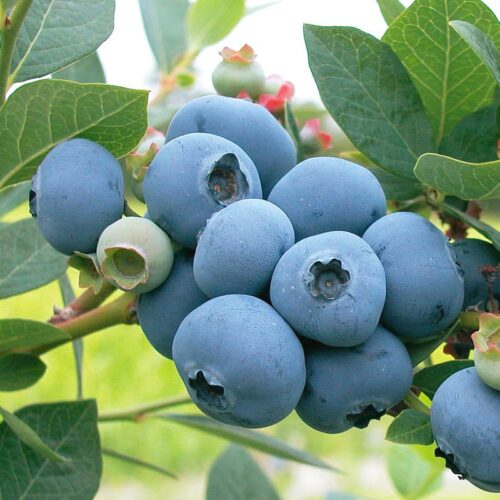
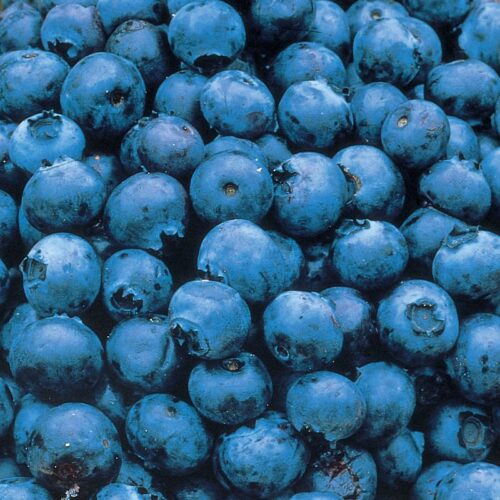
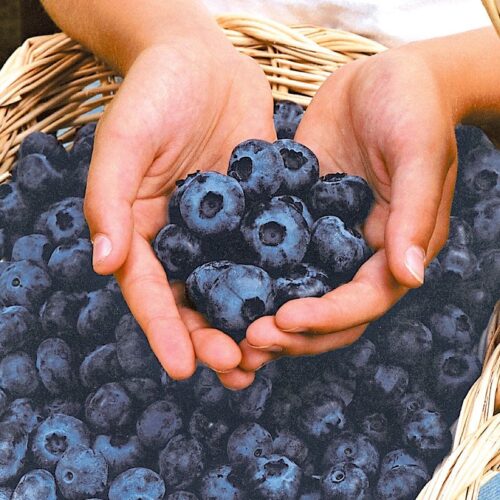
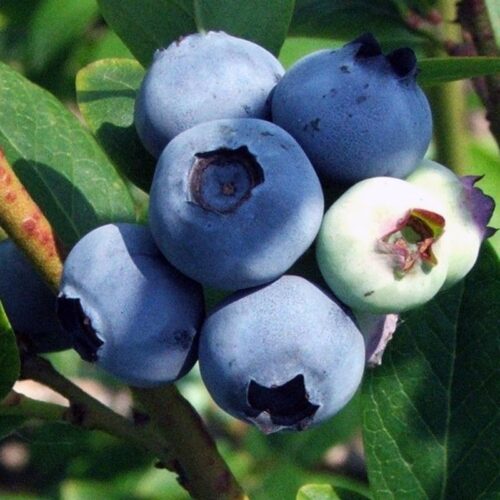


April this post was packed with delicious and hardy information. The fun little jokes and side comments kept me wanting to read more! Thanks so much for sharing. I will be applying this information throughout the summer as I teach campers aged 5-18+ about gardening.
Yay! So glad to be spreading gardening info to kids! 🙂